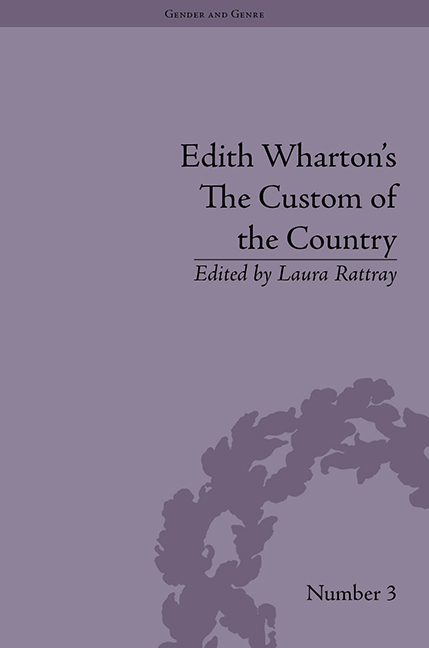Book contents
- Frontmatter
- CONTENTS
- Acknowledgements
- Editorial Note
- List of Contributors
- List of Figures
- Introduction
- 1 The Custom of the Country: Edith Wharton's Conversation with the Atlantic Monthly
- 2 When the Reading Had to Stop: Readers, Reading and the Circulation of Texts in The Custom of the Country
- 3 ‘Don't Cry – it ain't that Kind of a Story’: Wharton's Business of Fiction, 1908–12
- 4 Worst Parents Ever: Cultures of Childhood in The Custom of the Country
- 5 Crude Ascending the Staircase: Undine Spragg and the Armory Show
- 6 ‘It's Better to Watch’: Compulsive Voyeurism in The Custom of the Country and The House of Mirth
- 7 A ‘Mist of Opopanax’: Mapping the Scentscape of The Custom of the Country
- 8 Landscape with the Fall of Undine
- 9 Girls from the Provinces: Wharton's Undine Spragg and Cather's Thea Kronborg
- 10 Men at Work in The Custom of the Country
- 11 ‘Lost in Translation’: Financial Plots and the Modernist Reader in The Custom of the Country
- Notes
- Index
5 - Crude Ascending the Staircase: Undine Spragg and the Armory Show
- Frontmatter
- CONTENTS
- Acknowledgements
- Editorial Note
- List of Contributors
- List of Figures
- Introduction
- 1 The Custom of the Country: Edith Wharton's Conversation with the Atlantic Monthly
- 2 When the Reading Had to Stop: Readers, Reading and the Circulation of Texts in The Custom of the Country
- 3 ‘Don't Cry – it ain't that Kind of a Story’: Wharton's Business of Fiction, 1908–12
- 4 Worst Parents Ever: Cultures of Childhood in The Custom of the Country
- 5 Crude Ascending the Staircase: Undine Spragg and the Armory Show
- 6 ‘It's Better to Watch’: Compulsive Voyeurism in The Custom of the Country and The House of Mirth
- 7 A ‘Mist of Opopanax’: Mapping the Scentscape of The Custom of the Country
- 8 Landscape with the Fall of Undine
- 9 Girls from the Provinces: Wharton's Undine Spragg and Cather's Thea Kronborg
- 10 Men at Work in The Custom of the Country
- 11 ‘Lost in Translation’: Financial Plots and the Modernist Reader in The Custom of the Country
- Notes
- Index
Summary
He was not blind to her crudity and her limitations, but they were a part of her grace and her persuasion.
The Custom of the Country (p. 83)[I]n the high dark dining-room with mahogany doors and dim portraits of ‘Signers’ and their females, she felt a conscious joy in her ascendency.
The Custom of the Country (p. 90)In the early months of 1913, the American public was fairly unanimous in its response to the International Exhibition of Modern Art held at New York's Armory of the 69th Regiment. Better known as the Armory Show, the exhibition was organized by a newly formed avant-garde group called the Association of American Painters and Sculptors (AAPS). The show attracted some 100,000 visitors and featured approximately 1,600 works, introducing the unsuspecting United States to modern American and European visual art. The event was exhaustively covered in the press, which made Marcel Duchamp's Nude Descending a Staircase No. 2 (1912) at once a scandal and the butt of many jokes. The gallery displaying Cubism was labelled ‘The Chamber of Horrors’ while Duchamp's painting, which captures multiple angles of a mechanized figure in motion, was ridiculed by viewers as ‘a lot of disused golf clubs and bags’, ‘an explosion in a shingle factory’ and an ‘academic painting of an artichoke’.
- Type
- Chapter
- Information
- Edith Wharton's The Custom of the CountryA Reassessment, pp. 71 - 86Publisher: Pickering & ChattoFirst published in: 2014



